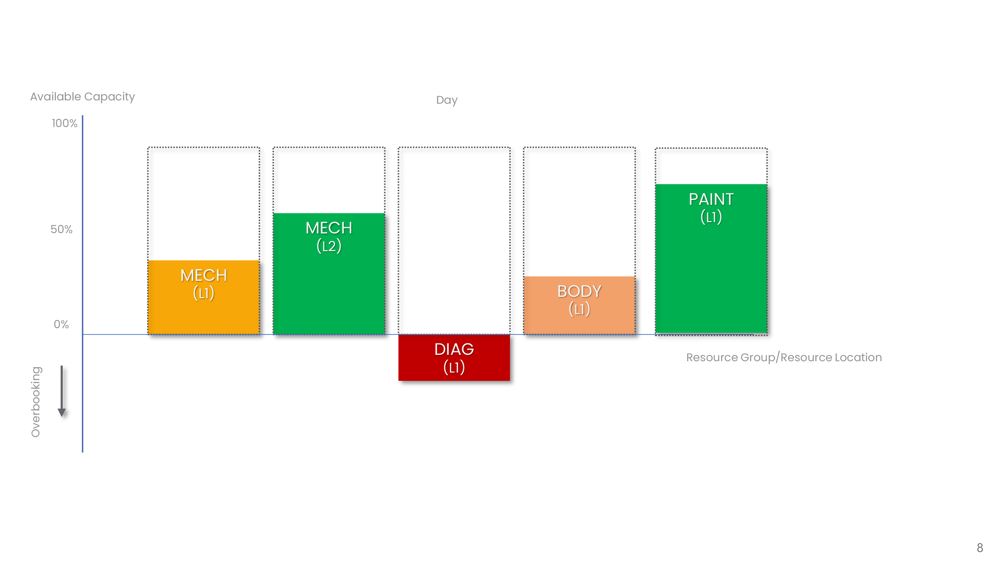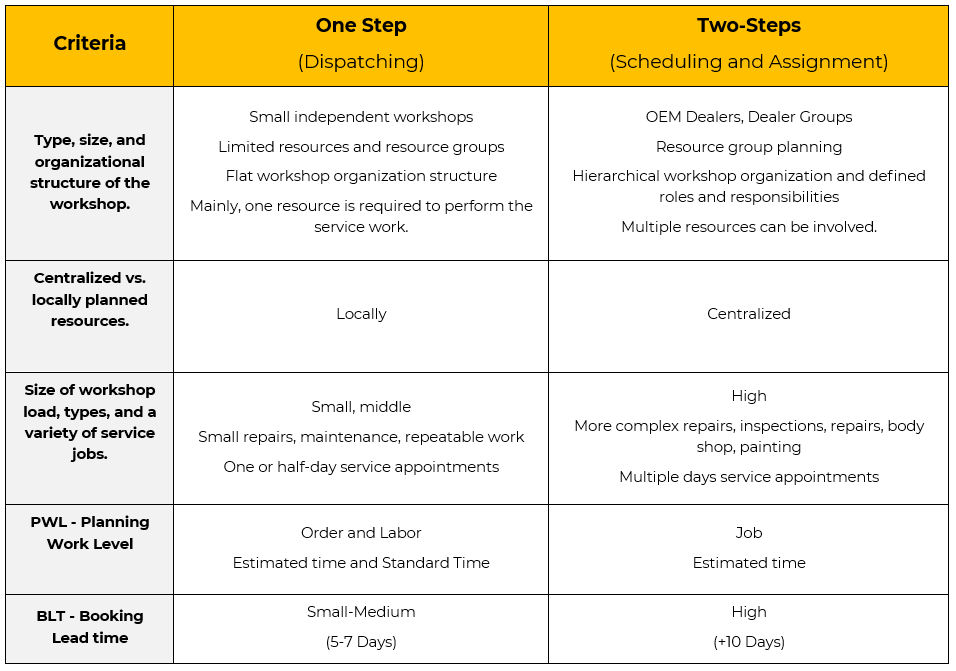How dealers operate with workshop resources. How to make the process more practical?

Intro
Throughout my professional career, I have been fortunate to visit various workshops, ranging from small independent businesses to large dealerships and dealer groups, as well as various original equipment manufacturers (OEMs) in different countries. This gives me perspective to articulate and observe criteria on how dealers operate process-wise with workshop resources.
Let's begin by addressing some important questions:
- What is the recommended process and technique to plan workshop resources effectively?
- Can we clearly articulate process dependencies, limits, and pros and cons?
- What is the impact of different booking processes on workshop utilization?
I want to answer those questions in my next article and explain the details and my views.
My note: The article and information I have provided are based on my observations and involvement in a software design group. Our team was responsible for creating workshop planning tools tailored to dealer processes. I used this experience extensively. I have added notes for each topic to clarify essential details further and highlight key points. These notes may be helpful to you.
Terminology
Let's start with basic definitions to ensure we're on the same page and using the correct terminology. This is important as there is a lack of documentation in the field. Secondly, to understand the concept, we must introduce the main players in the “game.”
There is a simple equation. On the one hand, there is a need to schedule multiple service appointments for various service jobs, while on the other hand, the workshop has limited resources to carry out the work. The primary responsibility of Workshop Resource Management is to efficiently utilize, organize, schedule, and dispatch workshop resources and balance available resources against demand.
Workshop Resources
Typical workshop resources are persons, machines (including tools and accessories), work bays, and mobility vehicles. Every resource has different skills, available capacity, and efficiency potential or level [L1].
My note: Service Advisors are also workshop resources; they perform reception and handover tasks, VHC, or pickup courtesy cars. Planning them brings extra benefits. Unfortunately, many dealers underestimate it, which causes issues with the workshop flow; I called those issues „Bottleneck Points.”
Resource Groups
Resources are typically used in groups to organize workshop activities effectively. Grouping can be done differently, and the main factors are the number of available resources and their diversity (type, skill, qualification). Typical resource grouping in the workshops is based on the following:
- Location (Dealer Site, Branch, Building, Facility…)
- Resource Skill (Mechanical, Bodyshop, Painting, Diagnostic, and Electrical …)
- Vehicle Brand or Type (OEM Make, Passenger Cars, Truck, Motorcycle)
or
- Team (Every team has a predefined skill set)
- Planning Shift (calendar planning, morning, afternoon, short and long shifts)
- Service Advisor (Service Advisors serve the role of team manager)
My note: Each resource group has available capacity, and things become more complex if one resource is shared between different resource groups, which is expected in the workshop. You may find information related to it here [L1]. The standard is to group resources based on their location and the type of work they can produce (mechanical, body shop, painting, diagnostics., electric….).
Service Work
Workshop resources perform service work, and the required resource capacity is typically booked on order, job, or labor (task) level. These booking levels we can call the Planning Work Level (PWL).
Also, service work has different types (mechanical, diagnostic, electrical, body, and painting), required capacities (based on OEM standard time or workshop estimate), and required skills (based on resource group).

Planning Work Level
My note: Example of Planning Work Level (PWL)
Order Level: Regular Maintenance after 30.000 Km
Job Level: Oil Service
Task: Change Oil and Oil Filter
Important is identifying the suitable Planning Work Level to which the workshop allocates its resource capacity for service work.
Scheduling Process
The scheduling booking process allocates resource capacity for service work on the resource group level without the need to assign specific resources.
My note: Let's imagine a pool of available resources per group reduced by the demand to perform service work. Such an overview helps dealers manage the workshop load. Dealer Management Systems (DMS) and Software Workshop Planning Tools (WPT) should assist. Assigning the required capacity and skill to PWL is a crucial detail to consider.

Assignments Process
Assignment booking relocates already booked (scheduled) resource capacity for service work from resource groups to a particular resource (two-step planning process).
My note: Some dealers only manage scheduling in their Dealer Management System (DMS) and Workshop Planning Tools (WPL) and assign service work manually (using a physical planning board). If so, they cannot fully leverage the benefits of a two-step planning process.
Dispatching Process
Dispatching booking allocates resource capacity for service work on the resource level (one-step planning process)
My note: Dispatching is necessary to allocate resource capacity for ad-hoc service work and walk-in customer visits where the scheduling process is unnecessary.
Planning Process
Now, let’s have a look at it all in one context.
Dealers use two main types of booking processes to allocate workshop resources for service work.
- One-Step Planning Process (Dispatching)
- Two-Steps Planning Process (Scheduling and Assignment)

Let's examine the main criteria for choosing a one or two-step planning process.
- Type, size, and organizational structure of the workshop.
- Centralized vs. locally planned resources.
- Size of workshop load, types, and a variety of service jobs.
- Preferred Planning Work Level (PWL).
- Booking Lead time BLT (Time needed to get service appointment).
Other criteria
The presence of aftersales lead management, booking centers, online appointment booking platforms, etc.
See the recommended type of booking process depending on the type of Planning Work Level - PWL.

Let's examine the pros and cons of choosing a one or two-step planning process.
One-Step Planning Process
Pros
+ Quick dispatching or re-dispatching of service work to resources.
+ Visibility of available resource time slots (calendar or agenda planning).
+ Flexible to manage Work in Progress (WIP), walk-ins, and ad-hoc planning.
+ Workshop controllers or planning centers are not required.
+ Suitable for “ticktack” and time-slot planning.
Cons
– A quick overview of available capacity (pool) is often absent due to missing resource group planning.
- Managing work overload and rescheduling required many steps and decisions.
– Complex repairs with multiple service jobs or repair days need precise planning and often cause planning issues.
– Long Booking Lead Time BLT or unpredicted resource absences cause regular planning changes and issues.
– Since service work is allocated directly to particular resources, only limited-service personnel book service work.
Summarization
The one-step planning process efficiently dispatches service work directly for workshop resources, suitable to manage resources locally, where a fixed number of resources are present and not shared between groups. The planning center or Workshop Controller is unnecessary because limited-service personnel, mainly service advisors, manage service appointments. The visibility of available resource time slots creates good conditions for booking repeated service work with a short repair time (mainly one-day service appointments) and enough flexibility to handle walk-ins and ad-hoc tasks.
Two-Step Planning Process
Pros
+ An organized workflow-driven booking process can significantly improve the organization of workshops and increase the level of workshop load.
+ Resource Capacity is allocated to the resource group level, making scheduling or rescheduling processes quick without allocating particular resources.
+ A two-step planning process enables less qualified service personnel and external applications (online booking platform) to schedule workshop capacity (Step 1.).
+ Planning changes occur less frequently because scheduling is done in the first step on resource groups rather than individual resources. This makes booking service appointments with Long Booking Lead Times – BLT uncomplicated.
+ Resource group planning helps to effectively manage higher workshop load, complex repairs, and rescheduling processes that require fewer steps and decision points.
Cons
– Requires a second step to reallocate resource capacity for service work. If not managed right, it may cause a bottleneck point in the service flow.
– Higher workshop organization, coordination, and administrative efforts. For instance, resources must be organized and managed in groups.
– Role: Workshop Controller or Resource Planner is highly recommended, where their main task is to assign service work to resources (Step 2.).
– Available time slots due to Long Booking Lead Times – BLT is hard to detect due to the resource group (pool) planning.
– Due to the capability to manage a higher daily workshop load, the two-step planning process is less flexible for ad-hoc planning or walk-ins.
Summarization
The two-step planning process (Scheduling + Assignment) is workflow-driven and offers a clear overview of available workshop capacity. It requires good workshop organization and defined roles and responsibilities. Assigning resources at the wrong time (too early or too late) can cause planning changes and bottleneck points, so workshop activities must be well coordinated (the main task of the workshop controller or planner).
Resources are assigned and managed in groups, and more individuals, including external applications (online booking platforms), can contribute to the booking process. For large dealers and dealers’ groups where planning centers are present, they can effectively manage workshop load and capacity from a central point. Group resource planning creates good conditions for managing a higher workshop load with Long Booking Times – LBT where potential changes are uncomplicated to master.
Result
As you may see, both planning process types have pros and cons. And every coin has two sides, and every problem has a solution.
For instance, dealers can effectively manage walk-ins and ad-hoc service jobs by allocating a specific resource capacity (10-15% middle-side dealers). OR, on the other hand, to utilize workshop resources most, dealers need to detect early indicators of no-show customer visits and respond proactively.
What matters is adjusting the process flow according to the expected workshop load. Counting the number of decision points and detecting potential bottlenecks will help to determine which process best fits the dealer's DNA and style of work.
I created the following table to summarize the findings and preferences.

I hope you like the insights and information provided. In the end, I want to mention another emergency trend to make workshop resource planning and utilization effective. Namely, complex resource allocation in service planning can be improved with AI. This is one of the topics I want to focus on next. Please feel free to contact me for further details.
Stay in touch!
Dr. Juraj Hanus
SME DMS | juraj.hanus@incadea.com
References:
[L1.]"How to distribute working hours in the Workshop #DMS" Dr. Juraj Hanus, Technical Article, April 20, 2017, How to distribute working hours in the Workshop #DMS